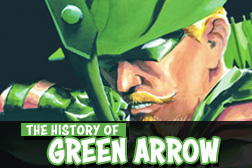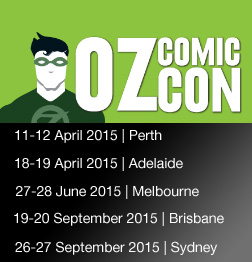With so many comics coming out every month, it’s hard to know what to choose. Some of them we read because we love the characters, others because they are essential to the canon. Then there’s those handful of titles that stand out as the best of the best.
This isn’t meant to be a comprehensive list, and nor does it include those excellent ongoing titles that have been running since at least last year. Things like Matt Fraction’s Hawkeye, Mark Waid’s Daredevil, Brian K. Vaughan’s Saga or Scott Snyder’s Batman, of course. We all love those. Technically, something like Dark Horse Presents gives us wonderful new material every month, but we’re always going to recommend that as well.
Hopefully, this list will give new readers a great place to get into the freshest comics, and old readers an excuse to go back and check out what they’ve been missing. Now, what did we miss?
Agree or disagree? Got a comment? Start a conversation below, or take it with you on Behind the Panel’s Facebook and Twitter!
If you are an iTunes user, subscribe to our weekly podcast free here and please leave us feedback.
Adventures of Superman – DC Comics, Various writers and artists
 While the Newish 52 has given Superman a less than consistent run, but this weekly digital-only series has provided us with some of the best Man of Steel stories in years. It kicked off with a tale by Jeff Parker and Chris Samnee, and it had us at “Jeff Parker and Chris Samnee”. Other people involved have included some of our favourite artists such as Riley Rossmo, and one by all-star creators J.M. DeMatteis, Giuseppe Camuncoli, and Sal Buscema. Our favourite so far has to be the tale of childhood imagination, told in the inimitable style of writer/artist Jeff Lemire. The most recent has an issue by Dan Abnett and Andy Lanning, with a cover by the heroic Bruce Timm. If this is a sign of what DC’s digital comics have to offer, then sign us up immediately for more of the same.
While the Newish 52 has given Superman a less than consistent run, but this weekly digital-only series has provided us with some of the best Man of Steel stories in years. It kicked off with a tale by Jeff Parker and Chris Samnee, and it had us at “Jeff Parker and Chris Samnee”. Other people involved have included some of our favourite artists such as Riley Rossmo, and one by all-star creators J.M. DeMatteis, Giuseppe Camuncoli, and Sal Buscema. Our favourite so far has to be the tale of childhood imagination, told in the inimitable style of writer/artist Jeff Lemire. The most recent has an issue by Dan Abnett and Andy Lanning, with a cover by the heroic Bruce Timm. If this is a sign of what DC’s digital comics have to offer, then sign us up immediately for more of the same.
Amala’s Blade – Dark Horse, Steve Horton (writer), Michael Dialynas (artist)
 First appearing in the pages of Dark Horse Presents, and later reprinted in Amala’s Blade #0, the debut issue began in 2013 so we’re counting it because we love it so much. It is a perfect jumping on point for this incredibly fun and lively new mini-series. We join Amala shortly after the events of the previous adventure, still plagued by the ghosts only she can see, hiding out in a bar with a large bounty on her head. After making a spectacle of herself in her latest assignment, the corpulent Vizier concocts to send her off on an assignment so dangerous that she has no hope of survival. However, this is Amala, and impossible is just another day. Horton’s previous story allowed little time for pause, and while this is a cracking adventure it also gives us some nice character building moments between Amala and the farming community she has bonded with. Dialynas’s art is the perfect compliment to Horton’s high adventure, a distinctive mix that sits somewhere between Steve Purcell and Riley Rossmo. It might be a truism, but these characters have character, which is a nice break from mainstream’s interchangeable genre puppets. A fascinating world where Steampunk meets Cyberpunk, it is sure to please both crowds and draw in those who are in virgin territory. Word to the wise tells us that this might extend beyond this limited series, but enjoy this while it lasts. It’s pure bliss.
First appearing in the pages of Dark Horse Presents, and later reprinted in Amala’s Blade #0, the debut issue began in 2013 so we’re counting it because we love it so much. It is a perfect jumping on point for this incredibly fun and lively new mini-series. We join Amala shortly after the events of the previous adventure, still plagued by the ghosts only she can see, hiding out in a bar with a large bounty on her head. After making a spectacle of herself in her latest assignment, the corpulent Vizier concocts to send her off on an assignment so dangerous that she has no hope of survival. However, this is Amala, and impossible is just another day. Horton’s previous story allowed little time for pause, and while this is a cracking adventure it also gives us some nice character building moments between Amala and the farming community she has bonded with. Dialynas’s art is the perfect compliment to Horton’s high adventure, a distinctive mix that sits somewhere between Steve Purcell and Riley Rossmo. It might be a truism, but these characters have character, which is a nice break from mainstream’s interchangeable genre puppets. A fascinating world where Steampunk meets Cyberpunk, it is sure to please both crowds and draw in those who are in virgin territory. Word to the wise tells us that this might extend beyond this limited series, but enjoy this while it lasts. It’s pure bliss.
East of West – Image Comics, Jonathan Hickman (writer), Nick Dragotta (artist)
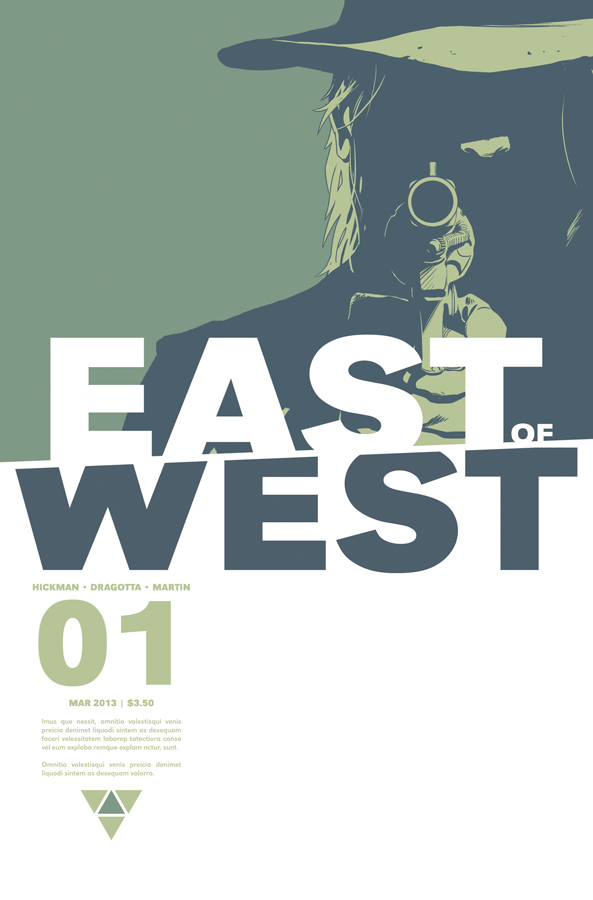 When East of West debuted in March, we commented that this “blend of Sci-Fi, Western and post-apocalyptic madness brings the weird for what is possibly the strongest debut of the year so far”. Very little has changed in the subsequent outings, although it is a series that demands your full attention. It’s almost as if Hickman decided to unleash every cool idea he’s ever had for a comic all at once, it is possible that a single read may not do this first issue just. Indeed, to fully soak in the plethora of ideas and deceptively simple nature of this world, it is a book that demands multiple reads. Dragotta re-teams with Hickman after a successful run on FF in the last few years, and this might be his crowing achievement. Also liberated from the shackles of drawing capes, Dragotta does the amazing work of bringing Hickman’s headspace to life. Accomplishing a seamless blend of Civil War era costumery with intricate slick future tech, it is a design that it visually compelling even when drenched in blood. Major props must go to colourist Frank Martin, who chooses a subdued colour palette that knows exactly when to burst into life. Make no mistake: this is dark and bloody territory. Yet it is also a rewarding and compelling read.
When East of West debuted in March, we commented that this “blend of Sci-Fi, Western and post-apocalyptic madness brings the weird for what is possibly the strongest debut of the year so far”. Very little has changed in the subsequent outings, although it is a series that demands your full attention. It’s almost as if Hickman decided to unleash every cool idea he’s ever had for a comic all at once, it is possible that a single read may not do this first issue just. Indeed, to fully soak in the plethora of ideas and deceptively simple nature of this world, it is a book that demands multiple reads. Dragotta re-teams with Hickman after a successful run on FF in the last few years, and this might be his crowing achievement. Also liberated from the shackles of drawing capes, Dragotta does the amazing work of bringing Hickman’s headspace to life. Accomplishing a seamless blend of Civil War era costumery with intricate slick future tech, it is a design that it visually compelling even when drenched in blood. Major props must go to colourist Frank Martin, who chooses a subdued colour palette that knows exactly when to burst into life. Make no mistake: this is dark and bloody territory. Yet it is also a rewarding and compelling read.
Five Ghosts: The Haunting of Fabian Gray – Image Comics, Frank J. Barbiere (writer), Chris Mooneyham
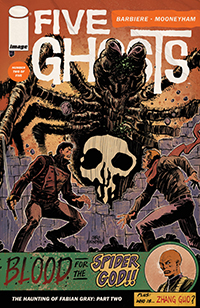 Five Ghosts completely knocked our socks off when it began in March, and for very good reason. Barbiere’s story is set on a solid foundation of old-school adventure stories, and the titular Fabian Gray being a man possessed by five literary ghosts that grant him special abilities. When we enter the story, Gray appears to be having trouble controlling the darker aspects of his abilities. Ancient tribesman, giant spiders and mystical forces conspire to make this a rapid-fire read, one that might literally have you sitting perched on the edge of your chair waiting for the next issue to emerge. Perhaps the cleverest thing about Barbiere’s writing is that he never feels the need to over-explain the powers or actions of his lead. Like the best pulp adventures (although using ‘pulp’ here is really only to describe the inspiration), we simply accept that these mystical happenings are the norm in Fabian Gray’s world. It’s not done with the irony of The League of Extraordinary Gentlemen either, it simply delivers a rip-roaring adventure that gives us more questions about the nature of Gray’s “tragic encounter” years ago. Equally dazzling is Chris Mooneyham’s distinctive vintage art style, that captures the spirit of the pulp adventures that inspire it, raising it to the epic proportions of Alan Moore’sTales of the Black Freighter. The colours and style are deliberately retro, and S.M Vidaurri is the unsung colourist hero of the volume. Bringing rich life to Barbiere and Mooneyham’s creations, this is an action serial brought to vivid life.
Five Ghosts completely knocked our socks off when it began in March, and for very good reason. Barbiere’s story is set on a solid foundation of old-school adventure stories, and the titular Fabian Gray being a man possessed by five literary ghosts that grant him special abilities. When we enter the story, Gray appears to be having trouble controlling the darker aspects of his abilities. Ancient tribesman, giant spiders and mystical forces conspire to make this a rapid-fire read, one that might literally have you sitting perched on the edge of your chair waiting for the next issue to emerge. Perhaps the cleverest thing about Barbiere’s writing is that he never feels the need to over-explain the powers or actions of his lead. Like the best pulp adventures (although using ‘pulp’ here is really only to describe the inspiration), we simply accept that these mystical happenings are the norm in Fabian Gray’s world. It’s not done with the irony of The League of Extraordinary Gentlemen either, it simply delivers a rip-roaring adventure that gives us more questions about the nature of Gray’s “tragic encounter” years ago. Equally dazzling is Chris Mooneyham’s distinctive vintage art style, that captures the spirit of the pulp adventures that inspire it, raising it to the epic proportions of Alan Moore’sTales of the Black Freighter. The colours and style are deliberately retro, and S.M Vidaurri is the unsung colourist hero of the volume. Bringing rich life to Barbiere and Mooneyham’s creations, this is an action serial brought to vivid life.
Jupiter’s Legacy – Image Comics, Mark Millar (writer), Frank Quitely (artist)
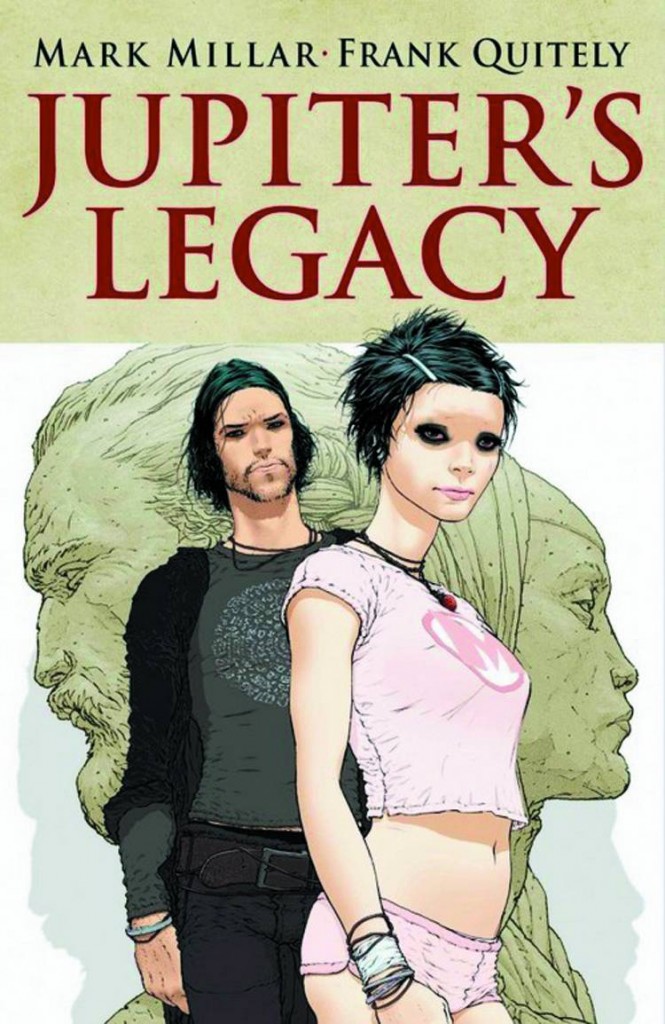 Possibly the most anticipated title of the year, the teaming of Mark Millar and phenomenal artist Frank Quitely was instantly going to be a big seller. It’s 1932, and Sheldon Sampson is compelled to visit an island that doesn’t exist to the rest of the world. Upon its discovery, he and his companions return to civilisation imbued with abilities that make them heroes to a faltering world. Cut to 2013, and the children of that generation no longer feel the weight of the great responsibility that comes with their great power. They are the superhero equivalent of trust fund babies, with Chloe and Brandon Sampson in particular caught between pressure and apathy in this uncertain future. Millar’s short runs have always been his strength, and it’s interesting to see him once again work on an ongoing book. Jupiter’s Legacy is a strong opening to what has the potential to be a terrific dissection of comics in the 21st century, a topic that Millar is well and truly familiar with at this stage in his career. Millar re-teams with the unique Frank Quitely (The Authority) for some finely detailed interior art. At one point in the first issue, an older Sheldon Sampson traps a villain inside a “psychic painting”, which transitions from working art to finished design within a single panel. A roster of compelling characters, lovingly illustrated by Quitely, certainly put this on a must-read pile for next month and the foreseeable future.
Possibly the most anticipated title of the year, the teaming of Mark Millar and phenomenal artist Frank Quitely was instantly going to be a big seller. It’s 1932, and Sheldon Sampson is compelled to visit an island that doesn’t exist to the rest of the world. Upon its discovery, he and his companions return to civilisation imbued with abilities that make them heroes to a faltering world. Cut to 2013, and the children of that generation no longer feel the weight of the great responsibility that comes with their great power. They are the superhero equivalent of trust fund babies, with Chloe and Brandon Sampson in particular caught between pressure and apathy in this uncertain future. Millar’s short runs have always been his strength, and it’s interesting to see him once again work on an ongoing book. Jupiter’s Legacy is a strong opening to what has the potential to be a terrific dissection of comics in the 21st century, a topic that Millar is well and truly familiar with at this stage in his career. Millar re-teams with the unique Frank Quitely (The Authority) for some finely detailed interior art. At one point in the first issue, an older Sheldon Sampson traps a villain inside a “psychic painting”, which transitions from working art to finished design within a single panel. A roster of compelling characters, lovingly illustrated by Quitely, certainly put this on a must-read pile for next month and the foreseeable future.
Miniature Jesus – Image Comics, Ted McKeever (writer/artist)
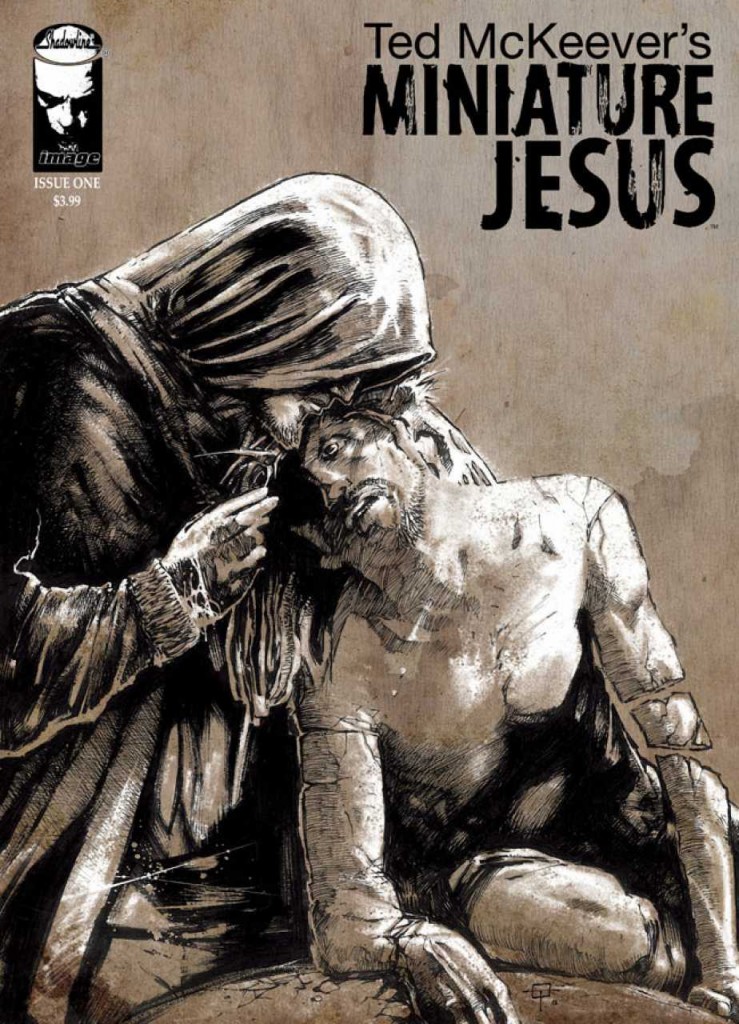 Opening with the subtly beautiful language of Walt Whitman, renaissance man Ted McKeever raises the bar for comics a little this year with the disarmingly brilliant Miniature Jesus. For the comics world, the twisted and the religious have come together in Garth Ennis’ Preacher or more recently in Sean Murphy’s outstanding Punk Rock Jesus, but this might be something closer to Cormac McCarthy’s nihilistic view of America. Set in a desolate wasteland, almost devoid of buildings and humans, McKeever cracks open the battle between good and evil and seems to find at least one of them absent. The literal manifestation of Chomsky’s demons may seem like an obvious take on an inner journey through his character’s mind/body/spirit, but it is simply part of the bizarre piece of theatre that McKeever is staging for us. Two decades before, McKeever examined a war between demons and angels in Metropol, except that was in a modern industrial setting. Here, McKeever has almost emptied his landscape, save for the miscreants and misfits who fill his story. It’s a stunning new series from someone who has already mastered the surreal. Here we watch him harness it, darken it and ride it hard for our entertainment. Bring it on.
Opening with the subtly beautiful language of Walt Whitman, renaissance man Ted McKeever raises the bar for comics a little this year with the disarmingly brilliant Miniature Jesus. For the comics world, the twisted and the religious have come together in Garth Ennis’ Preacher or more recently in Sean Murphy’s outstanding Punk Rock Jesus, but this might be something closer to Cormac McCarthy’s nihilistic view of America. Set in a desolate wasteland, almost devoid of buildings and humans, McKeever cracks open the battle between good and evil and seems to find at least one of them absent. The literal manifestation of Chomsky’s demons may seem like an obvious take on an inner journey through his character’s mind/body/spirit, but it is simply part of the bizarre piece of theatre that McKeever is staging for us. Two decades before, McKeever examined a war between demons and angels in Metropol, except that was in a modern industrial setting. Here, McKeever has almost emptied his landscape, save for the miscreants and misfits who fill his story. It’s a stunning new series from someone who has already mastered the surreal. Here we watch him harness it, darken it and ride it hard for our entertainment. Bring it on.
Neomad – Gestalt Comics, Yijala Yala Project/Sutu and the Love Punks
 This might be one of the most interesting projects you’ve never heard of, especially if you are outside Australia. Another reason to dip into digital comics, this would be included on the list simply because it combines animation, live action film, music and voice overs in a way that makes this a holistic experience. Set in the Pilbara Desert of Western Australia, it also features the participation of 30 young indigenous youths from Ieramugadu (Roebourne) from the Pilbara, who can be seen and heard throughout the three episodes of Neomad. In a region known for its mining industry, the group has spend the past year developing their digital media skills by using Photoshop and graphic tablets donated by Wacom. It’s a post-apocalyptic tale that also incorporates elements of the Dreaming and youthful exuberance. It’s a joy to watch, especially given that the user feels as though they are participating in the process as well. The first episode was launched in Korea last year, but Episode 3 has just been launched via the iPad app. Australia and Gestalt have really been showcasing the best we have to offer over the last few years, and projects like this are exactly why. This is the kind of story that makes comics fun again, and we hope to see more from this talented young group in the future.
This might be one of the most interesting projects you’ve never heard of, especially if you are outside Australia. Another reason to dip into digital comics, this would be included on the list simply because it combines animation, live action film, music and voice overs in a way that makes this a holistic experience. Set in the Pilbara Desert of Western Australia, it also features the participation of 30 young indigenous youths from Ieramugadu (Roebourne) from the Pilbara, who can be seen and heard throughout the three episodes of Neomad. In a region known for its mining industry, the group has spend the past year developing their digital media skills by using Photoshop and graphic tablets donated by Wacom. It’s a post-apocalyptic tale that also incorporates elements of the Dreaming and youthful exuberance. It’s a joy to watch, especially given that the user feels as though they are participating in the process as well. The first episode was launched in Korea last year, but Episode 3 has just been launched via the iPad app. Australia and Gestalt have really been showcasing the best we have to offer over the last few years, and projects like this are exactly why. This is the kind of story that makes comics fun again, and we hope to see more from this talented young group in the future.
The Private Eye – Panel Syndicate, Brian K. Vaughan (writer), Marcos Martin, Muntsa Vicente (artists)
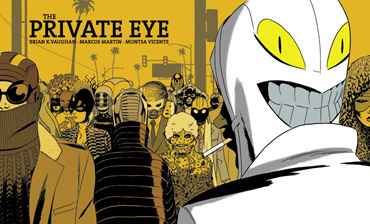 Crowd-sourced and kickstarted comics are increasingly commonplace these days, but it’s a rare treat when Brian K. Vaughan and Marcos Martin want to free themselves from publisher shackles. The first issue of a planned ten was a roaring success, garnering praise for its originality and “name your price” distribution methods. Having enough money to continue the project, Vaughan continues to unfold his intriguing world. Set in a future where privacy is a sacred right, and everybody wears masks of various levels of sophistication, information is the most powerful commodity. Our P.I. continues on the trail of something big, this future noir following a very traditional yet effective narrative trope. Martin’s artwork is bold and daring, using the landscape format to give the reader a sense of cinema. Muntsa Vicente’s colours vividly populate every frame, allowing for single colours to fill the background for increased emphasis. By the way, if you do download this, don’t be a chump: give the people some money. It goes straight into the creators’ pockets. They suggest .99c, but we kicked in a fiver for the first issue, and about the same for the second and third so far. We really want to see this make it to the end, and all things being equal, it should make it there with little delay. So wait no longer and head to the Panel Syndicate website and fork out some wads of digital cash now.
Crowd-sourced and kickstarted comics are increasingly commonplace these days, but it’s a rare treat when Brian K. Vaughan and Marcos Martin want to free themselves from publisher shackles. The first issue of a planned ten was a roaring success, garnering praise for its originality and “name your price” distribution methods. Having enough money to continue the project, Vaughan continues to unfold his intriguing world. Set in a future where privacy is a sacred right, and everybody wears masks of various levels of sophistication, information is the most powerful commodity. Our P.I. continues on the trail of something big, this future noir following a very traditional yet effective narrative trope. Martin’s artwork is bold and daring, using the landscape format to give the reader a sense of cinema. Muntsa Vicente’s colours vividly populate every frame, allowing for single colours to fill the background for increased emphasis. By the way, if you do download this, don’t be a chump: give the people some money. It goes straight into the creators’ pockets. They suggest .99c, but we kicked in a fiver for the first issue, and about the same for the second and third so far. We really want to see this make it to the end, and all things being equal, it should make it there with little delay. So wait no longer and head to the Panel Syndicate website and fork out some wads of digital cash now.
Sex – Image Comics, Joe Casey (wrtier), Piotr Kowalski (artist)
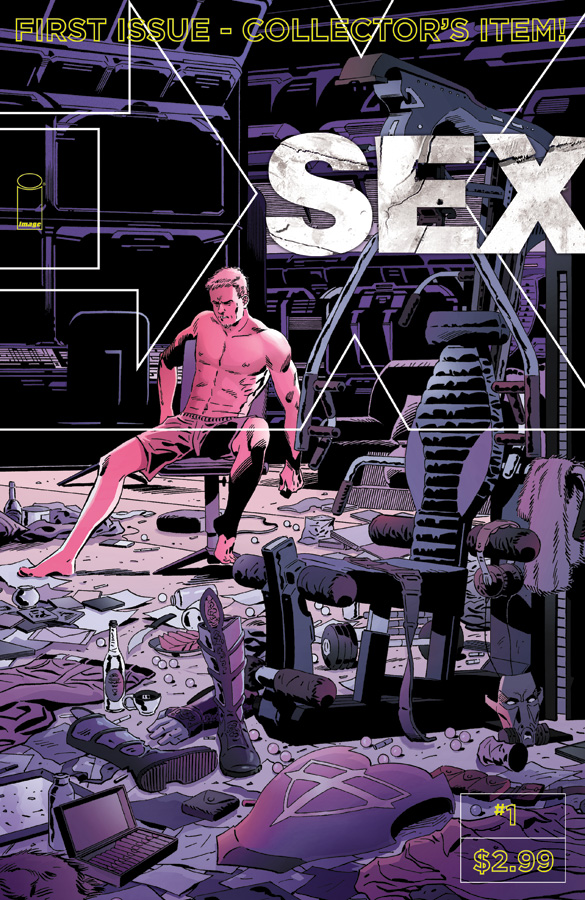 Sex sells but there is a lot more to Joe Casey’s series than mere titillation. If for no other reason, Jose Casey’s Sex needs to be applauded for being unafraid to put the subject of most superhero comics front and centre in his dialogue with the genre. Piotr Kowalski’s art immediately sets the scene, a gritty mixture of closeness and crime, not a million miles away from the colour schemes of Sean Phillips on Ed Brubaker’s work. Casey takes the sexuality that superhero comics have always toyed with, from bondage ropes to latex outfits, and makes it more overt. Yet at the same time, this is not what readers might expect from the explicit title. Granted, it contains graphic depictions of peep-show lesbian encounters, but Casey has already firmly established his world by then. Former costumed crime-fighter Sam Cooke returns to a city he has watched fall into decay, and with the Old Man ready to take over control of the town again, Cooke finds it impossible to connect to a life out of costume. Cooke’s despair is a tangible entity, and while half of the readers may pick this up for some beautifully rendered skin, the rest of us will stay for Casey’s world-building. Cooke is something of a post-Batman stand-in, playing off the Catwoman-like femme fatale Annabelle Lagravenese. Like the deed itself, Sex seems outwardly straightforward but promises a wealth of exciting complications down the track.
Sex sells but there is a lot more to Joe Casey’s series than mere titillation. If for no other reason, Jose Casey’s Sex needs to be applauded for being unafraid to put the subject of most superhero comics front and centre in his dialogue with the genre. Piotr Kowalski’s art immediately sets the scene, a gritty mixture of closeness and crime, not a million miles away from the colour schemes of Sean Phillips on Ed Brubaker’s work. Casey takes the sexuality that superhero comics have always toyed with, from bondage ropes to latex outfits, and makes it more overt. Yet at the same time, this is not what readers might expect from the explicit title. Granted, it contains graphic depictions of peep-show lesbian encounters, but Casey has already firmly established his world by then. Former costumed crime-fighter Sam Cooke returns to a city he has watched fall into decay, and with the Old Man ready to take over control of the town again, Cooke finds it impossible to connect to a life out of costume. Cooke’s despair is a tangible entity, and while half of the readers may pick this up for some beautifully rendered skin, the rest of us will stay for Casey’s world-building. Cooke is something of a post-Batman stand-in, playing off the Catwoman-like femme fatale Annabelle Lagravenese. Like the deed itself, Sex seems outwardly straightforward but promises a wealth of exciting complications down the track.
Ten Grand – Image Comics, J. Michael Straczynski (writer), Ben Templesmith (artist)
 Two masters team up for a blaze through hell and back, giving a fresh new spin to a familiar concept. J. Michael Straczynski brings his Joe’s Comics imprint back with a new creator-owned series, joining 30 Days of Night creator Ben Templesmith to deliver one of the more surprising books of the season. If you have been lamenting the death of Hellblazer, and DC’s Constantine replacement just doesn’t do it for you, then it is time to meet Joe Fitzgerald. The concept of a weary detective type who straddles an occult line between this world and the next has to recall Constantine, and perhaps this is a knowing reference. To JMS’s credit, while the idea may be (more than) similar, he has enough interesting ideas to distinguish himself from that long-standing title. Ten Grand does a wonderful job of slowly building and drawing the reader into a pre-defined world. Here heaven and hell is present wherever Joe goes, from strip clubs to WiFi servers that have very literal firewalls for trespassers. Templesmith’s art is outstanding as expected, finding a way to tell us so much with very simple lines and figures. His choice of colours – greys, blues, rusty browns and oranges – don’t typically lend themselves to visual intrigue, but here he somehow imbues them with either a warmth or a complete absence of it when the occasion arises. It’s probably too early to declare Ten Grand a new masterpiece, but it is definitely one you should have on your monthly pull list.
Two masters team up for a blaze through hell and back, giving a fresh new spin to a familiar concept. J. Michael Straczynski brings his Joe’s Comics imprint back with a new creator-owned series, joining 30 Days of Night creator Ben Templesmith to deliver one of the more surprising books of the season. If you have been lamenting the death of Hellblazer, and DC’s Constantine replacement just doesn’t do it for you, then it is time to meet Joe Fitzgerald. The concept of a weary detective type who straddles an occult line between this world and the next has to recall Constantine, and perhaps this is a knowing reference. To JMS’s credit, while the idea may be (more than) similar, he has enough interesting ideas to distinguish himself from that long-standing title. Ten Grand does a wonderful job of slowly building and drawing the reader into a pre-defined world. Here heaven and hell is present wherever Joe goes, from strip clubs to WiFi servers that have very literal firewalls for trespassers. Templesmith’s art is outstanding as expected, finding a way to tell us so much with very simple lines and figures. His choice of colours – greys, blues, rusty browns and oranges – don’t typically lend themselves to visual intrigue, but here he somehow imbues them with either a warmth or a complete absence of it when the occasion arises. It’s probably too early to declare Ten Grand a new masterpiece, but it is definitely one you should have on your monthly pull list.
The Wake – DC/Vertigo, Scott Snyder (writer), Sean Murphy (artist)
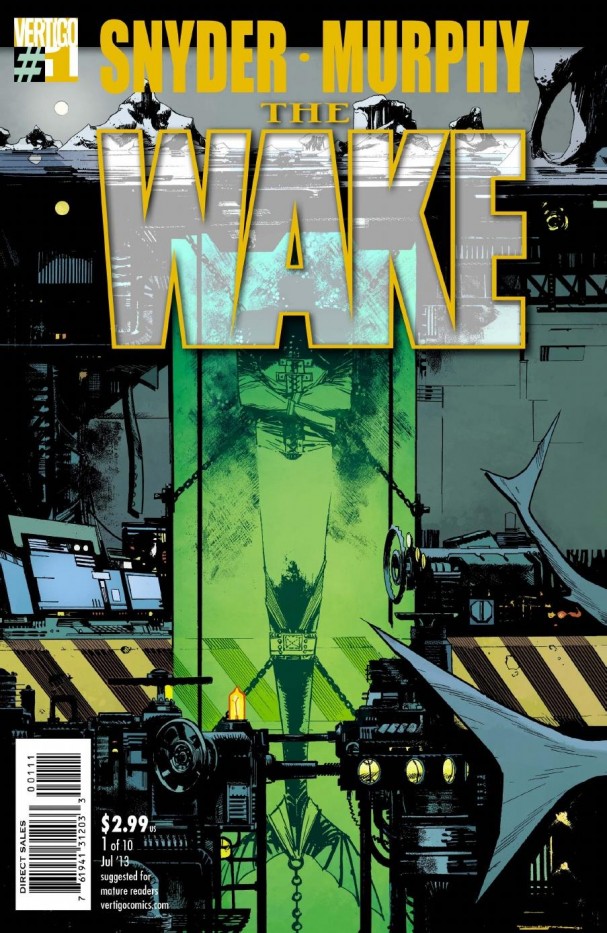 The other ‘most anticipated’ book of the first half of the year. While DC/Vertigo may not have experienced as many highs in the past year as they have in decades gone by, some of their bigger titles have been from Scott Snyder (American Vampire) and Sean Murphy (Punk Rock Jesus). Yet the union of the hottest writer in the industry right now (for Batman) and arguably the most visually arresting artist in Murphy is something to get excited about, and The Wake doesn’t disappoint. From the first panel, The Wake immediately hooks you into a story that seems like no other. Yet more than anything, Snyder has created a complete world, one that is both lived-in and ripe for exploration. Murphy’s art is gorgeous. If you had most recently seen his work on the gritty black and white pages of Punk Rock Jesus, it is almost a shock to the system to see his style spring to vivid new life with a colour job. The colourist is, of course, also one of the best in the business. Matt Hollingsworth (Hawkeye) brings his distinctive palette to The Wake, mixing understated hues with an idiosyncratic combination of ‘worn’ and dotted backgrounds. With some maxi-series, it is sometimes worth waiting until the book finishes playing out to dip in. This will not be the case with The Wake, which delivers individual issues that are intriguing, filled with well-rounded characters and surprising at each turn. Put together by a team of creators all at the top of their game, we are genuinely excited to see this unfold over the next year.
The other ‘most anticipated’ book of the first half of the year. While DC/Vertigo may not have experienced as many highs in the past year as they have in decades gone by, some of their bigger titles have been from Scott Snyder (American Vampire) and Sean Murphy (Punk Rock Jesus). Yet the union of the hottest writer in the industry right now (for Batman) and arguably the most visually arresting artist in Murphy is something to get excited about, and The Wake doesn’t disappoint. From the first panel, The Wake immediately hooks you into a story that seems like no other. Yet more than anything, Snyder has created a complete world, one that is both lived-in and ripe for exploration. Murphy’s art is gorgeous. If you had most recently seen his work on the gritty black and white pages of Punk Rock Jesus, it is almost a shock to the system to see his style spring to vivid new life with a colour job. The colourist is, of course, also one of the best in the business. Matt Hollingsworth (Hawkeye) brings his distinctive palette to The Wake, mixing understated hues with an idiosyncratic combination of ‘worn’ and dotted backgrounds. With some maxi-series, it is sometimes worth waiting until the book finishes playing out to dip in. This will not be the case with The Wake, which delivers individual issues that are intriguing, filled with well-rounded characters and surprising at each turn. Put together by a team of creators all at the top of their game, we are genuinely excited to see this unfold over the next year.
X-Men – Marvel, Brian Wood (writer), Olivier Coipel (artist)
 Brian Wood and Olivier Coipel confidently deliver their take on an all-female X-Men team that reminds us of how good it can get. Wood eases into this book with the experience and affection of someone who has spent years living and breathing the X-Men, both on the pre-Marvel NOW version of this title and Ultimate Comics: X-Men. The fact that this is set in and around the same locations as the plethora of other X-titles and nary a Y chromosome is to be seen is an accomplishment in itself. Along with the principal cast of women, characters such as Pixie and Bling populate the halls of the school, celebrating the diversity of super-powered women that the X-universe has to offer. At the end of the day, Wood’s X-Men is an action comic, and the effortless way in which he slides Storm, Kitty and Rogue into a runaway train of a sequence. Coipel, the French superstar perhaps best known for House of M and Thor, is the other leading light in this reboot. Bringing the full set of his talents to bear, he continues to display a mastery of action sequences and layout. Yet in this book more than any other, the human element is the most important, and that aforementioned bouncing bundle of joy is drawn with the same sentiment that can be found in Wood’s writing. Marvel have shown faith in this as one of their flagship X-titles by assigning it two of the hottest names on their roster, a characteristic of the whole Marvel NOW relaunch. Every bit as vital, or arguably more so, than Uncanny X-Men and the umpteen Wolverine excursions, this starts a new era of X-Men with a bang.
Brian Wood and Olivier Coipel confidently deliver their take on an all-female X-Men team that reminds us of how good it can get. Wood eases into this book with the experience and affection of someone who has spent years living and breathing the X-Men, both on the pre-Marvel NOW version of this title and Ultimate Comics: X-Men. The fact that this is set in and around the same locations as the plethora of other X-titles and nary a Y chromosome is to be seen is an accomplishment in itself. Along with the principal cast of women, characters such as Pixie and Bling populate the halls of the school, celebrating the diversity of super-powered women that the X-universe has to offer. At the end of the day, Wood’s X-Men is an action comic, and the effortless way in which he slides Storm, Kitty and Rogue into a runaway train of a sequence. Coipel, the French superstar perhaps best known for House of M and Thor, is the other leading light in this reboot. Bringing the full set of his talents to bear, he continues to display a mastery of action sequences and layout. Yet in this book more than any other, the human element is the most important, and that aforementioned bouncing bundle of joy is drawn with the same sentiment that can be found in Wood’s writing. Marvel have shown faith in this as one of their flagship X-titles by assigning it two of the hottest names on their roster, a characteristic of the whole Marvel NOW relaunch. Every bit as vital, or arguably more so, than Uncanny X-Men and the umpteen Wolverine excursions, this starts a new era of X-Men with a bang.



